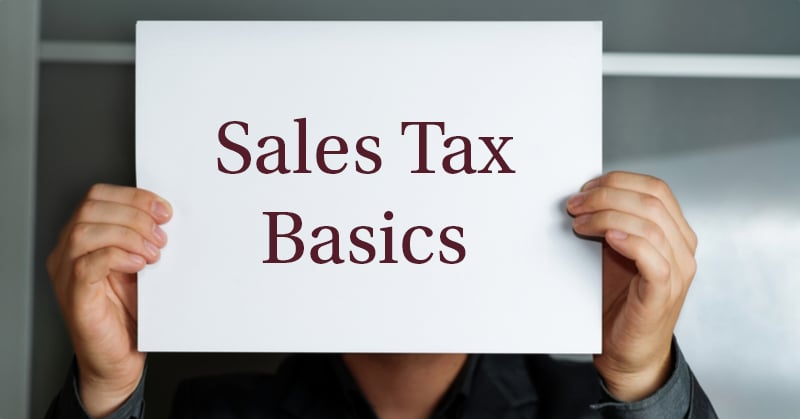Tax accountants know that they need to stay up to date on the latest sales tax changes and compliance rules so as to properly advise their clients. However, it’s also important for all accountants and bookkeepers to go back to basics and ensure their clients have laid the proper foundation for a scalable sales tax compliance strategy designed to keep their business safe from audit risk for today and tomorrow.
Below are key areas to managing sales tax compliance for growing organizations.
Documenting Sales Tax Processes
With the "Great Resignation" impacting businesses everywhere, all organizations should ensure that their teams are properly set up for success. This is especially true in the world of tax compliance where monthly filing obligations continue unabated, no matter how temporarily short-staffed a team may be.
If they haven’t already, advise your clients to document their processes and to do it sooner rather than later. The most efficient and thoughtful set of compliance procedures will count for nothing if their creator leaves the company without writing it all down so the next person has a place to start.
Evaluating Sales Tax Nexus
Accountants must understand both physical nexus and economic nexus requirements to properly advise clients on their compliance footprint. Now that we live in a world where almost every state in the country with a sales tax has enacted an economic nexus requirement, it’s easy to forget that physical presence nexus still exists. It creates an obligation even for sellers with few sales into a state.
Remember, economic nexus standards and thresholds vary from state to state and some are still tweaking their rules from time to time. Also, while Missouri does not have an active economic nexus requirement in force today, it will as of January 2023.
You should support your clients in establishing a routine of periodically reviewing their nexus footprint for any changes. As businesses expand organically or through acquisition, they may find themselves with either an expanded physical footprint or suddenly crossing an economic nexus threshold.
Remember the impact of remote employees as well. Having an in-state employee frequently creates physical presence nexus, even if that employee is not involved in the sales process. Your clients should check in frequently with their HR teams to check if they hired any new remote staff or if an existing employee has moved. If your client hasn't thought about nexus for a while, you may be doing right by them by offering up a fresh nexus study.
Addressing New Sales Tax Obligations
If a fresh review of nexus reveals that your client has an expanded obligation, think about registration. If you are looking at one or more of the 24 member states of the Streamlined Sales Tax (SST) Program, consider using the SST Central Registration System. It really and truly is the easiest way to register a seller for sales tax.
Better yet, if the seller qualifies, consider using a Certified Service Provider (CSP) under the SST Model 1 program. For many companies, Model 1 can represent a cost-effective and time-saving option for sales tax management.
If you determined that your client may have met a nexus requirement in a given state a while back but never came into compliance, voluntary disclosure agreements (VDAs) may also need to be considered. VDAs can be an effective tool in minimizing the tax, penalty and interest exposure of non-compliance. With VDAs, remember the following:
- By keeping your client anonymous to start, initial negotiations can be initiated without the company fully committing itself to the process
- VDAs won’t shield you from paying taxes due, but they can limit the lookback period and take penalties off the table
- Some states will reduce the interest charged when dealing with taxpayers who have voluntarily disclosed their non-compliance
- A VDA is no longer possible once a seller has been contacted by a state about the possibility of past liability
Understanding Taxability and Sales Tax Remittance
Understanding how products and/or services are taxed in different jurisdictions is critical for your clients as they seek to keep their customers happy while still collecting all the tax due and payable for every sale. No business wants to deal with angry customers complaining that they were charged tax on a non-taxable sale. The only thing worse is dealing with an auditor telling them they didn't collect tax where they should have.
Remember that each state has its own set of rules on which goods (and sometimes services) are subject to tax. There can be extremely minute differences between what is and is not taxable. On top of that, rates and rules change all the time. If your client does not have a procedure in place to track rate changes, they should. If they haven't reviewed the taxability of what they sell in a while, they need to.
The last step in the tax compliance process involves knowing how to correctly file sales tax returns. Knowing the permissible filing methods and the specific forms/schedules that are required (and each one’s return due dates) is essential. Your clients should also understand what is properly reported on each line of the sales tax return.
Sales tax compliance should not overburden employees or derail businesses as they grow. Learn more about how to get sales tax complexity off your plate, so you can get on with running your business.
.png?width=150&height=63&name=TWRlogo-regmark_blueblack%20(1).png)
.png)










Do you have questions about this article? Email us and let us know > info@woodard.com
Comments: